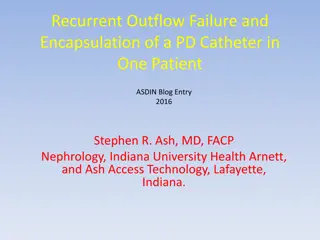Suprapubic Catheter Insertion Procedure Guidelines
Suprapubic catheter insertion is a procedure indicated for conditions such as urethral injury, obstruction, bladder neck masses, and benign prostatic hypertrophy. It involves proper patient positioning, analgesia, equipment preparation, and a step-by-step technique including bladder palpation, marking, draping, anesthesia infiltration, and catheter insertion. Clinical contraindications include a lack of bladder visualization, coagulopathy, and bowel adhesions. Adequate post-insertion care and securing of the catheter are essential for patient comfort and safety.
Download Presentation

Please find below an Image/Link to download the presentation.
The content on the website is provided AS IS for your information and personal use only. It may not be sold, licensed, or shared on other websites without obtaining consent from the author.If you encounter any issues during the download, it is possible that the publisher has removed the file from their server.
You are allowed to download the files provided on this website for personal or commercial use, subject to the condition that they are used lawfully. All files are the property of their respective owners.
The content on the website is provided AS IS for your information and personal use only. It may not be sold, licensed, or shared on other websites without obtaining consent from the author.
E N D
Presentation Transcript
SUPRAPUBIC CATHETER INSERTION PREPARED BY SHANE BARCLAY MD
Indications 1. Urethral injury 2. Urethral obstruction 3. Bladder neck masses 4. Benign prostatic hypertrophy resulting in obstruction.
Contraindications 1. Inability to palpate or visualize bladder on ultrasound. 2. Coagulopathy 3. Bowel adhesion to the bladder
Analgesia If patient is awake it is highly recommended they receive IV procedural analgesia with or without sedation.
Equipment There are many commercially available kits which contain all the equipment you will need. Refer to your local resources. The BARD suprapubic catheter will be reviewed here.
Technique 1. Patient supine. 2. Provide adequate analgesia +/- sedation. 3. Clean the lower abdominal wall 4. Shave area if necessary. 5. Palpate bladder and mark insertion 4-5 cm above pubic symphysis. 6. Better yet, visualize bladder with ultrasound and mark site.
Technique 7. Apply antiseptic solution from pubis to umbilicus 8. Apply sterile drapes 9. Using 10 cc syringe with local anesthesia infiltrate insertion site. 10. Then continue through the skin, SC tissue, rectus sheath and down while alternating injection and aspiration. Eventually you should aspirate urine into the syringe.
Technique 11. Using #11 scalpel blade make small stab incision at insertion site. 12. Place your nondominant hand on the lower abdominal wall. Stabilize the unit between the thumb and index fingers. The dominant hand should be used to advance the unit. Insert the Bard catheter at a 20-30 degree angle caudally towards the patient s feet. You should feel the trocar pop into the bladder.
Technique 13. Apply drain dressings around the catheter and secure the catheter with either tape or suture.























